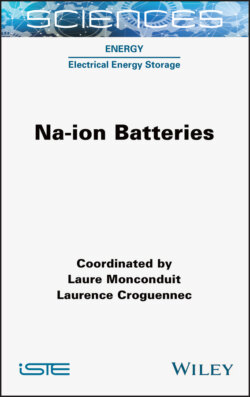Читать книгу Na-ion Batteries - Laure Monconduit - Страница 22
1.2.3. Structural changes of P2-NaxMO2 by Na extraction
ОглавлениеFigure 1.7. Schematic illustrations of (a) P2-type and two choices of O2-type structures and (b) ideal O2 in choice 1 and a structural model with random stacking of Of-e and Oe-f layers as completely desodiated [Ni,Mn]O2 (left) and ideal OP4-type and a structural model with random stacking of PP2 and OO2 layers with simultaneous random stacking of Of-e and Oe-f layers (right). Reprinted with permission from Kubota et al. (2018b) Copyright 2018, Wiley-VCH. (c) Na+/vacancy ordering observed for P2-Na2/3CoO2 and P′2-Na1/2CoO2. For a color version of this figure, see www.iste.co.uk/monconduit/batteries.zip
P2-type materials generally transform in the P2 → O2 sequence by gliding MO2 slabs during Na extraction during the charging process (Lu and Dahn 2001a; Berthelot et al. 2011). However, the phase transition is not strictly accurate and is more complicated in the actual reaction. According to the literature (Lu and Dahn 2001a), O2-type phase contains stacking faults between two different O2-type stackings (Figure 1.7(a)). The two choices of slab-gliding, (1/3, 2/3, 0) and (2/3, 1/3, 0) vectors for the slab with BA oxygen-stacking in the P2-type AB BA stacking, form two types of O2-type structures possessing different oxygen stacking manners of AB CB and AB AC, respectively. Furthermore, the two O2-type stacking phases coexists with the P2-type one in the specific voltage plateau region at ~4.2 V. Our group proposed formation of the two different O2 types stacking and staking faults as a P2-O2 intergrowth structure for Na2/3-xNi1/4Mn2/3Cu1/12O2 instead of the ideal OP4-type one (Figure 1.7(b)) with simulated synchrotron X-ray diffraction (XRD) patterns using DIFFaX software (Treacy et al. 1991; Kubota et al. 2017). Similar to O3 type, P2-type materials also have Na+/vacancy orderings in the interslab spacing typically for x = 2/3 and 1/2 in NaxMO2, as shown in Figure 1.7(c) (Hinuma et al. 2008; Berthelot et al. 2011; Lee et al. 2013).
These phase transitions were usually confirmed by ex situ and in situ/operando XRD and transmission electron microscopy (TEM) measurements. The phase transitions highly depend on the transition metals. In order to understand the characteristics of each transition metal in O3-NaMO2 and P2-Na2/3MO2, single 3d transition metal O3 and P2 systems are reviewed before each of the multiple transition metal systems.
